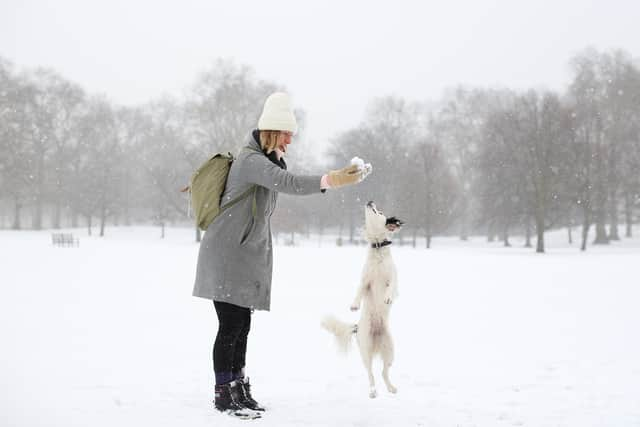UK snow: Met Office verdict on date ‘Beast from the East’ could bring coldest day of the year
and live on Freeview channel 276
Met Office has warned that snow and ice could cause disruption in the UK in the coming days.
Forecasters have said a sudden stratospheric warming event is “likely” as the prospect of subzero conditions grows. Reports have suggested that the mercury could plunge as low as -7C could be seen in parts of the country.
Advertisement
Hide AdAdvertisement
Hide AdMilder than average temperatures are expected in the short term before turning cooler towards the end of February. The Mirror reports maps from WXCharts show temperatures could drop to -7C and 15 centimetres of snow could fall.
But when could a ‘beast from the east’ arrive and what is the cause of it? Here is all you need to know:
Met Office delivers verdict on when arctic freeze could arrive
The forecaster has issued a pair of yellow weather warnings for snow and ice on Monday (6 March) and Tuesday (7 March) for parts of northern England and large parts of Scotland. It comes as amber cold weather alerts were also issued by the UKHSA.
In its forecast for Saturday (4 March) to Monday (6 March), the forecaster predicts: “Often cloudy with a scattering of mainly light showers. Some breaks, mainly to the lee of high ground. Becoming colder from the northeast, with snow and hail showers by Monday.”
Advertisement
Hide AdAdvertisement
Hide AdFor the next nine days, from 6 March to 15 March, the Met Office forecasts: “This period is expected to be characterised by winds from the north bringing cold conditions to most areas. This will most likely result in wintry showers across northern and eastern areas, these turning to more organised bands of snow at times. Under this regime, many other areas are likely to remain dry with some sunshine, the best of this across inland areas and in the south and west of the UK.
“During the later part of the period confidence decreases significantly, however there is a risk of some milder and wetter weather pushing into the south from the Atlantic, meaning spells of rain will become more likely across the country. Temperatures overall will be below average but may gradually trend up through the period.”


What is a Sudden Stratospheric Warming?
The atmospheric event was the cause behind the Beast from the East in early 2018. During the winter storms, temperatures plunged as low as -14C in places and caused £1.2 billion in damages.
Snow storms brought disruptions, stranded traffic and wintry conditions to the UK in February and March of that year. But what is a Sudden Stratospheric Warming event?
Advertisement
Hide AdAdvertisement
Hide AdOn its website, the Met Office explains: “Every year in winter, strong westerly winds circle around the pole high up in the stratosphere. This is called the stratospheric polar vortex and it circulates around cold air high over the Arctic.
“In some years, the winds in the polar vortex temporarily weaken, or even reverse to flow from east to west. The cold air then descends very rapidly in the polar vortex and this causes the temperature in the stratosphere to rise very rapidly, as much as 50°C over only a few days; hence the term sudden stratospheric warming.
“As the cold air from high up in the stratosphere disperses, it can affect the shape of the jet stream as the cold air sinks from the stratosphere into the troposphere. It is this change in the jet stream that causes our weather to change.
“The stratospheric sudden warming can sometimes cause the jet stream to ‘snake’ more, and this tends to create a large area of blocking high pressure. Typically this will form over the North Atlantic and Scandinavia.
Advertisement
Hide AdAdvertisement
Hide Ad“This means that northern Europe, including the UK is likely to get a long spell of dry, cold weather, whereas southern Europe will tend to be more mild, wet and windy. On the boundary of these areas, cold easterly winds develop and in some cases the drop in temperatures leads to snow, which is what happened in early 2018.”
Comment Guidelines
National World encourages reader discussion on our stories. User feedback, insights and back-and-forth exchanges add a rich layer of context to reporting. Please review our Community Guidelines before commenting.